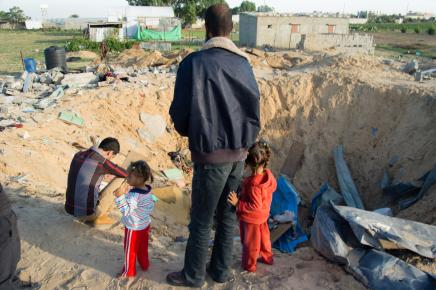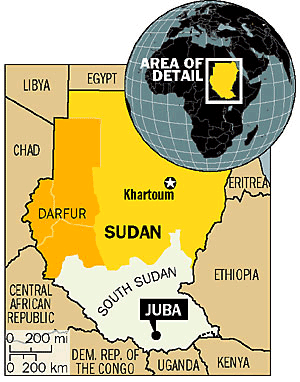Left Speechless
Doctors and Medics Operate Under Fire and Siege in Gaza
December 5, 2012
Gaza City- Dr. Majdi Na’eim worked for eight consecutive days at Al-Shifa Hospital throughout Israel’s “Pillar of Cloud” operation in the Gaza strip. With hundreds of wounded pouring into the emergency room, there was no time for him and many of his colleagues to even leave the hospital. On the final and one of the most brutal days of the assault, Israel targeted Ni’ma tower in Gaza City. Dr. Na’eim was in the emergency room aiding physicians when he learned that one of the arriving casualties was his two year old son, Abdel Rahman Na’eim. Imagine a father’s horror and instant grief. At his son’s wake, Dr. Na’eim told friends and family who were seeking to comfort him, “I’m terribly sorry. I’m unable to talk about anything.”

Gazans in the medical field have been working in unimaginable circumstances for years. During Israel’s Operation Cast Lead, “17 health personnel were killed and 26 injured. In total, 29 ambulances were damaged or destroyed by bombs or crushed by armoured vehicles, while 48 per cent of Gaza’s 122 health facilities were either directly or indirectly hit by shelling.” On November 29th, 2012, Bashar Abu Murad, head of emergency and rescue services at the Palestine Red Crescent, sat down with our delegation and gave us a first-hand account of the January 15th, 2009, attack on Al-Quds hospital. He described the panic as the hospital sustained two white phosphorus blasts from Israeli forces. A massive fire broke out after the first munitions were launched. It took six hours to squelch the fire with only water and sand bags. Workers frantically scrambled to evacuate patients and others who were taking refuge. Meanwhile, a journalist hid under the table. Bashar personally carried three people from the intensive care unit to safety. Though the first fire was eventually stopped, the hospital was rendered useless after a second shelling of white phosphorus.
Our conversation moved to the experiences of this war. Though Al-Quds hospital was not directly attacked this time and the doctors there had not seen evidence of injuries from white phosphorus, they described third degree burns and amputations caused from Israel’s “non-lethal” warning bombs and the many casualties from larger missiles fired from F16s financed by the United States. Bashar spoke of the difficulties of functioning as a medical service in a society under siege. Emergency medical technicians must improvise without basic supplies like gauze for the injured and enough body bags for the intake of casualties. Field medics and emergency medical technicians have limited contact with the hospitals because the blockade restricts them to having only insufficient analogue radios instead of modern digital communications technology. Al-Quds was running off of a gas generator due to the unstable supply of electricity. The hospital had just attained a three month buffer supply of basic medicines, all of which were depleted in the conflict. Abu Murad continued, “It is hard to even think clearly in these conditions. All 1.5 million Gazans are suffering from PTSD from this war.” The doctors were not excluded from his statement.
Later that afternoon, we interviewed two young ambulance drivers, Shadi al Tayef and Aadl el Azbot. We asked them how they summoned the courage to carry on in this work during the recent war after ambulances were targeted in Operation Cast Lead. Shadi replied, “This war was not unfamiliar from the last. In the final days, the streets were empty. Everyone was waiting in their houses. We do it only because we care about saving the people. It is all for the people.” Aadl continues to drive ambulances and is not deterred even though he was previously injured by shrapnel when the Israelis fired upon a site for the second time after the emergency vehicles arrived. According to the drivers, the Israeli military had to be aware of the emergency medics’ presence, not only from the elaborate surveillance systems comprised of drones and hot-air balloons equipped with cameras, but also because they must first coordinate every rescue mission with the Red Cross which is in direct contact with the Israeli military. Ambulance workers have often been denied access to sites until it is too late to save the wounded, only to be fired upon after receiving clearance. “We are still suffering from trauma even up to this moment,” Aadl declared anxiously. The Red Crescent society does offer psychological services to its employees, but it hard to conceive that it can keep up with the level of need. Six ambulances were destroyed and seven workers were injured during the “Pillar of Cloud” conflict. “We must cope with the situation at work, but we are given space to be human and take time at home,” Shadi asserted.
Countries and organizations sympathetic to Gazans working under fire have extended medical and financial solidarity to provide services to the population and rebuild facilities. Around the corner from Al-Quds, we toured a Moroccan military field hospital which was set up just days after the major hostilities ended. Initially, we were somewhat intimidated by the long lines, tight Moroccan security surrounding the compound and the foreboding looking communications director. Wearing opaque sun glasses, full army fatigues and towering over six feet tall, this public relations representative looked more like a commander than a humanitarian worker. We were put at ease when he welcomed us proudly, “Ahlan wa Sahlan,”and readily introduced us to the primary physician.
Dr. Hassan Ismael explained that the Moroccan King ordered the hospital to be equipped with 26 doctors and 15 specialists. As of the 4th of December, the doctors had been working for nine days, seeing over 4000 people and providing over 6000 services for no cost to the patients. Services include treatment for severe burns and broken bones, emergency surgical operations and the dispensing of medicines, many of which were not regularly available in Gaza. The doctors were also happy to provide care for illnesses not related to the war. We met with a refugee, originally from Jaffa, who received injections for severe arthritis. She stood up immediately, waving her arms emphatically. “These doctors are from God… A gift from the God!” she repeats. Nearby, a father from Khan Younis finally found appropriate treatment for his epileptic son.
It was impressive to see the quality and efficiency of what was taking place in the field hospital when the military infrastructure, which is so often used by the majority of countries for nothing more than a tool of domination and destruction, was converted to serve human needs. When much of the world stood by silently and watched, Moroccans also set up a similar medical camp and provided financial aid to rebuild Al-Quds hospital after Operation Cast Lead.
Members from the international emergency delegation to Gaza reached out to their circles to raise around 25,000 dollars for medication to give to Gazan hospitals. Though the doctors and administrators we encountered were grateful for the donations and gestures, they emphasized that the problem that Gaza is facing is primarily political. They desire an end to the siege, occupation, military incursions and the right to self- determination, among other concrete demands. They welcomed support, but they do not want to be reliant upon international aid. They have the training, knowledge and dedication to do their jobs well and to be self-sufficient. Dr. Khalil Abu-Foul, a spokesperson for the Red Crescent, gave us a reality check, “You are our eyes in your country. These rockets are from your country. Just send the facts, it’s enough.”
Sitting with families over the past week, most of whom have “facts on the ground” and stories every degree as distressing as that of Dr. Majdi Na’eim’s tragic loss of his son, I have often felt a complete lack of words. What can one say when visiting the home and farm of Walid and Tawqfiq al Nassasra, Bedouin farmers and brothers living near Rafah? On November 19th at 10 PM, an Israeli war plane targeted Tawqfiq’s tin-roof home. The house was completely destroyed leaving a massive crater in the ground. Tawqfiq’s two teenage sons, Ahmed and Mohamed, were both killed. They did not suffer any bone fractures. The pressure from the bomb caused their internal organs to explode. It is amazing there were any survivors. Tawqfiq is still hospitalized, while his wife was blinded and his young daughter was severely burned. What apologies will matter to the wife or daughter, who are now permanently disfigured and disabled, whose tearful gazes pierced our lifeless cameras and shredded our notebooks full of numbers and statistics? What prospects for recovery or receiving advanced treatment do they have while Gaza is still under siege? I grasped for some condolence. The words are insufficient. We all have a responsibility to take stronger actions so that these tragedies will never happen again.
Joshua Brollier is a co-coordinates Voices for Creative Nonviolence. He can be reached at joshua@vcnv.org.










